MARKETING
28 Case Study Examples Every Marketer Should See

Putting together a compelling case study is one of the most powerful strategies for showcasing your product and attracting future customers. But it’s not easy to create case studies that your audience can’t wait to read.
In this post, we’ll go over the definition of a case study and the best examples to inspire you.
What is a case study?
A case study is a detailed story of something your company did. It includes a beginning — often discussing a conflict, an explanation of what happened next, and a resolution that explains how the company solved or improved on something.
A case study proves how your product has helped other companies by demonstrating real-life results. Not only that, but marketing case studies with solutions typically contain quotes from the customer. This means that they’re not just ads where you praise your own product. Rather, other companies are praising your company — and there’s no stronger marketing material than a verbal recommendation or testimonial. A great case study is also filled with research and stats to back up points made about a project’s results.
There are myriad ways to use case studies in your marketing strategy. From featuring them on your website to including them in a sales presentation, a case study is a strong, persuasive tool that shows customers why they should work with you — straight from another customer. Writing one from scratch is hard, though, which is why we’ve created a collection of case study templates for you to get started.
Fill out the form below to access the free case study templates.
There’s no better way to generate more leads than by writing case studies. But without case study examples to draw inspiration from, it can be difficult to write impactful studies that convince visitors to submit a form.
Marketing Case Study Examples
To help you create an attractive and high-converting case study, we’ve put together a list of some of our favorites. This list includes famous case studies in marketing, technology, and business.
These studies can show you how to frame your company offers in a way that is both meaningful and useful to your audience. So, take a look, and let these examples inspire your next brilliant case study design.
These marketing case studies with solutions show the value proposition of each product. They also show how each company benefited in both the short and long term using quantitative data. In other words, you don’t get just nice statements, like “This company helped us a lot.” You see actual change within the firm through numbers and figures.
You can put your learnings into action with HubSpot’s Free Case Study Templates. Available as custom designs and text-based documents, you can upload these templates to your CMS or send them to prospects as you see fit.
 Download These Free Case Study Templates
Download These Free Case Study Templates
1. “How Handled Scaled from Zero to 121 Locations with the Help of HubSpot,” by HubSpot

What’s interesting about this case study is the way it leads with the customer. That reflects a major HubSpot cornerstone, which is to always solve for the customer first. The copy leads with a brief description of why the CEO of Handled founded the company and why he thought Handled could benefit from adopting a CRM. The case study also opens up with one key data point about Handled’s success using HubSpot, namely that it grew to 121 locations.
Notice that this case study uses mixed media. Yes, there is a short video, but it’s elaborated upon in the other text on the page. So while your case studies can use one or the other, don’t be afraid to combine written copy with visuals to emphasize the project’s success.
Key Learnings from the HubSpot Case Study Example
- Give the case study a personal touch by focusing on the CEO rather than the company itself.
- Use multimedia to engage website visitors as they read the case study.
2. “The Whole Package,” by IDEO

Here’s a design company that knows how to lead with simplicity in its case studies. As soon as the visitor arrives at the page, they’re greeted with a big, bold photo and the title of the case study — which just so happens to summarize how IDEO helped its client. It summarizes the case study in three snippets: The challenge, the impact, and the outcome.
Immediately, IDEO communicates its impact — the company partnered with H&M to remove plastic from its packaging — but it doesn’t stop there. As the user scrolls down, the challenge, impact, and progress are elaborated upon with comprehensive (but not overwhelming) copy that outlines what that process looked like, replete with quotes and intriguing visuals.
Key Learnings from the IDEO Case Study Example
- Split up the takeaways of your case studies into bite-sized sections.
- Always use visuals and images to enrich the case study experience, especially if it’s a comprehensive case study.
3. “Rozum Robotics intensifies its PR game with Awario,” by Awario

In this case study, Awario greets the user with a summary straight away — so if you’re feeling up to reading the entire case study, you can scan the snapshot and understand how the company serves its customers. The case study then includes jump links to several sections, such as “Company Profile,” “Rozum Robotics’ Pains,” “Challenge,” “Solution,” and “Results and Improvements.”
The sparse copy and prominent headings show that you don’t need a lot of elaborate information to show the value of your products and services. Like the other case study examples on this list, it includes visuals and quotes to demonstrate the effectiveness of the company’s efforts. The case study ends with a bulleted list that shows the results.
Key Learnings from the Awario Robotics Case Study Example
- Create a table of contents to make your case study easier to navigate.
- Include a bulleted list of the results you achieved for your client.
4. “Chevrolet DTU,” by Carol H. Williams

If you’ve worked with a company that’s well-known, use only the name in the title — like Carol H. Williams, one of the nation’s top advertising agencies, does here. The “DTU,” stands for “Discover the Unexpected.” It generates interest because you want to find out what the initials mean.
They keep your interest in this case study by using a mixture of headings, images, and videos to describe the challenges, objectives, and solutions of the project. The case study closes with a summary of the key achievements that Chevrolet’s DTU Journalism Fellows reached during the project.
Key Learnings from the Carol H. Williams Case Study Example
- If you’ve worked with a big brand before, consider only using the name in the title — just enough to pique interest.
- Use a mixture of headings and subheadings to guide users through the case study.
5. “How Fractl Earned Links from 931 Unique Domains for Porch.com in a Single Year,” by Fractl

Fractl uses both text and graphic design in their Porch.com case study to immerse the viewer in a more interesting user experience. For instance, as you scroll, you’ll see the results are illustrated in an infographic-design form as well as the text itself.
Further down the page, they use icons like a heart and a circle to illustrate their pitch angles, and graphs to showcase their results. Rather than writing which publications have mentioned Porch.com during Fractl’s campaign, they incorporated the media outlets’ icons for further visual diversity.
Key Learnings from the Fractl Case Study Example
- Let pictures speak for you by incorporating graphs, logos, and icons all throughout the case study.
- Start the case study by right away stating the key results, like Fractl does, instead of putting the results all the way at the bottom.
6. “The Met,” by Fantasy
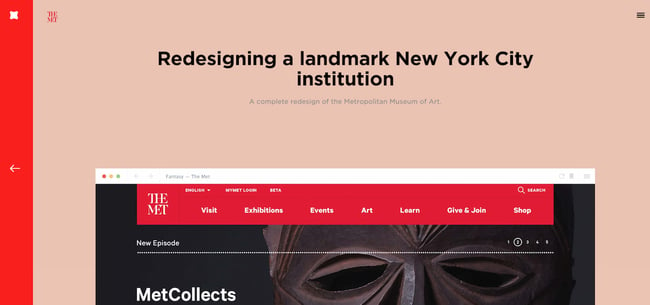
What’s the best way to showcase the responsiveness and user interface of a website? Probably by diving right into it with a series of simple showcases— which is exactly what Fantasy does on their case study page for the Metropolitan Museum of Art. They keep the page simple and clean, inviting you to review their redesign of the Met’s website feature-by-feature.
Each section is simple, showing a single piece of the new website’s interface so that users aren’t overwhelmed with information and can focus on what matters most.
If you’re more interested in text, you can read the objective for each feature. Fantasy understands that, as a potential customer, this is all you need to know. Scrolling further, you’re greeted with a simple “Contact Us” CTA.
Key Learnings from the Fantasy Case Study Example
- You don’t have to write a ton of text to create a great case study. Focus on the solution you delivered itself.
- Include a CTA at the bottom inviting visitors to contact you.
7. “Rovio: How Rovio Grew Into a Gaming Superpower,” by App Annie

If your client had a lot of positive things to say about you, take a note from App Annie’s Rovio case study and open up with a quote from your client. The case study also closes with a quote, so that the case study doesn’t seem like a promotion written by your marketing team but a story that’s taken straight from your client’s mouth. It includes a photo of a Rovio employee, too.
Another thing this example does well? It immediately includes a link to the product that Rovio used (namely, App Annie Intelligence) at the top of the case study. The case study closes with a call-to-action button prompting users to book a demo.
Key Learnings from the App Annie Case Study Example
- Feature quotes from your client at the beginning and end of the case study.
- Include a mention of the product right at the beginning and prompt users to learn more about the product.
8. “Embracing first-party data: 3 success stories from HubSpot,” by Think with Google

Google takes a different approach to text-focused case studies by choosing three different companies to highlight.
The case study is clean and easily scannable. It has sections for each company, with quotes and headers that clarify the way these three distinct stories connect. The simple format also uses colors and text that align with the Google brand.
Another differentiator is the focus on data. This case study is less than a thousand words, but it’s packed with useful data points. Data-driven insights quickly and clearly show how the value of leveraging first-party data while prioritizing consumer privacy.

Key Learnings from the Think with Google Case Study Example
- A case study doesn’t need to be long or complex to be powerful.
- Clear data points are a quick and effective way to prove value.
9. “In-Depth Performance Marketing Case Study,” by Switch
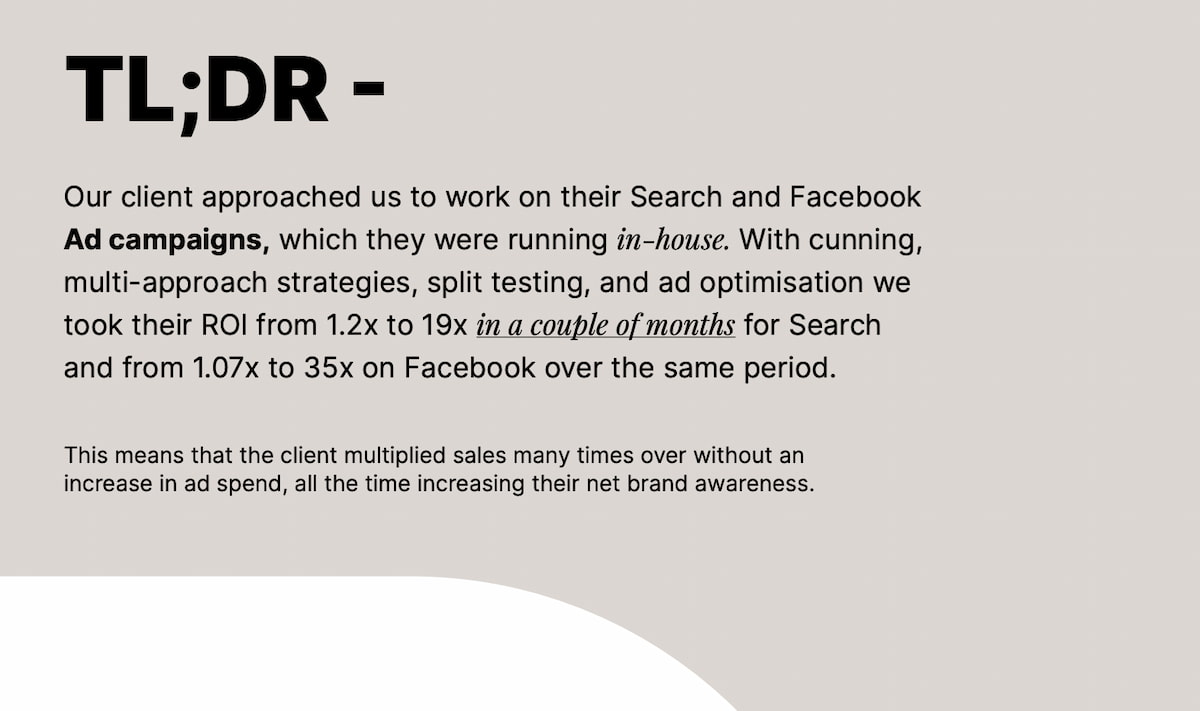
Switch is an international marketing agency based in Malta that knocks it out of the park with this case study. Its biggest challenge is effectively communicating what it did for its client without ever revealing the client’s name. It also effectively keeps non-marketers in the loop by including a glossary of terms on page 4.
The PDF case study reads like a compelling research article, including titles like “In-Depth Performance Marketing Case Study,” “Scenario,” and “Approach,” so that readers get a high-level overview of what the client needed and why they approached Switch. It also includes a different page for each strategy. For instance, if you’d only be interested in hiring Switch for optimizing your Facebook ads, you can skip to page 10 to see how they did it.
The PDF is fourteen pages long but features big fonts and plenty of white space, so viewers can easily skim it in only a few minutes.
Key Learnings from the Switch Case Study Example
- If you want to go into specialized information, include a glossary of terms so that non-specialists can easily understand.
- Close with a CTA page in your case study PDF and include contact information for prospective clients.
10. “Gila River,” by OH Partners
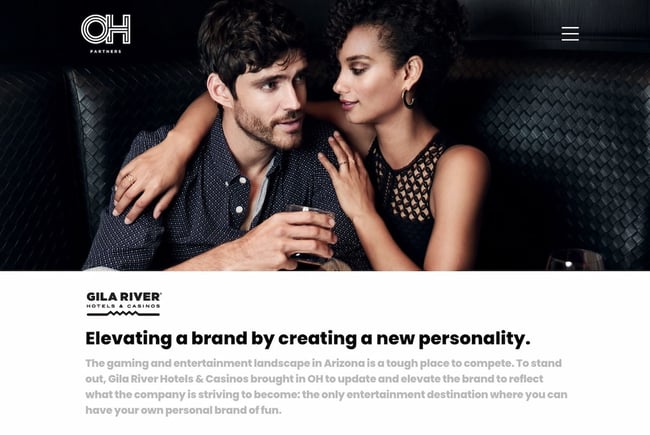
Let pictures speak for you, like OH Partners did in this case study. While you’ll quickly come across a heading and some text when you land on this case study page, you’ll get the bulk of the case study through examples of actual work OH Partners did for its client. You will see OH Partners’ work in a billboard, magazine, and video. This communicates to website visitors that if they work with OH Partners, their business will be visible everywhere.
And like the other case studies here, it closes with a summary of what the firm achieved for its client in an eye-catching way.
Key Learnings from the OH Partners Case Study Example
- Let the visuals speak by including examples of the actual work you did for your client — which is especially useful for branding and marketing agencies.
- Always close out with your achievements and how they impacted your client.
11. “Facing a Hater,” by Digitas
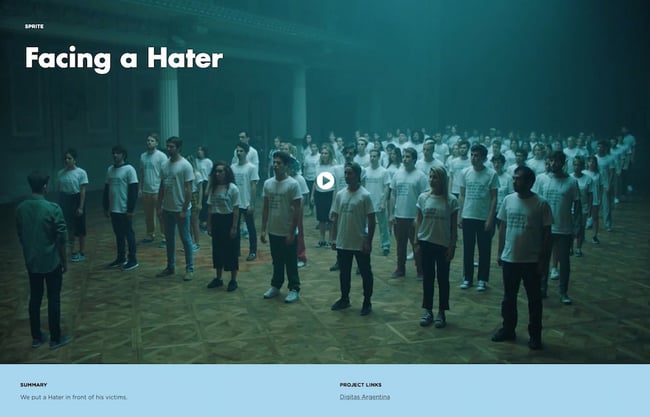
Digitas’ case study page for Sprite’s #ILOVEYOUHATER campaign keeps it brief while communicating the key facts of Digitas’ work for the popular soda brand. The page opens with an impactful image of a hundred people facing a single man. It turns out, that man is the biggest “bully” in Argentina, and the people facing him are those whom he’s bullied before.
Scrolling down, it’s obvious that Digitas kept Sprite at the forefront of their strategy, but more than that, they used real people as their focal point. They leveraged the Twitter API to pull data from Tweets that people had actually tweeted to find the identity of the biggest “hater” in the country. That turned out to be @AguanteElCofler, a Twitter user who has since been suspended.
Key Learnings from the Digitas Case Study Example
- If a video was part of your work for your client, be sure to include the most impactful screenshot as the heading.
- Don’t be afraid to provide details on how you helped your client achieve their goals, including the tools you leveraged.
12. “Better Experiences for All,” by HermanMiller

HermanMiller sells sleek, utilitarian furniture with no frills and extreme functionality, and that ethos extends to its case study page for a hospital in Dubai.
What first attracted me to this case study was the beautiful video at the top and the clean user experience. User experience matters a lot in a case study. It determines whether users will keep reading or leave. Another notable aspect of this case study is that the video includes closed-captioning for greater accessibility, and users have the option of expanding the CC and searching through the text.
HermanMiller’s case study also offers an impressive amount of information packed in just a few short paragraphs for those wanting to understand the nuances of their strategy. It closes out with a quote from their client and, most importantly, the list of furniture products that the hospital purchased from the brand.
Key Learnings from the HermanMiller Case Study Example
- Close out with a list of products that users can buy after reading the case study.
- Include accessibility features such as closed captioning and night mode to make your case study more user-friendly.
13. “Capital One on AWS,” by Amazon

Do you work continuously with your clients? Consider structuring your case study page like Amazon did in this stellar case study example. Instead of just featuring one article about Capital One and how it benefited from using AWS, Amazon features a series of articles that you can then access if you’re interested in reading more. It goes all the way back to 2016, all with different stories that feature Capital One’s achievements using AWS.
This may look unattainable for a small firm, but you don’t have to go to extreme measures and do it for every single one of your clients. You could choose the one you most wish to focus on and establish a contact both on your side and your client’s for coming up with the content. Check in every year and write a new piece. These don’t have to be long, either — five hundred to eight hundred words will do.
Key Learnings from the Amazon AWS Case Study Example
- Write a new article each year featuring one of your clients, then include links to those articles in one big case study page.
- Consider including external articles as well that emphasize your client’s success in their industry.
14. “HackReactor teaches the world to code #withAsana,” by Asana

While Asana’s case study design looks text-heavy, there’s a good reason. It reads like a creative story, told entirely from the customer’s perspective.
For instance, Asana knows you won’t trust its word alone on why this product is useful. So, they let Tony Phillips, HackReactor CEO, tell you instead: “We take in a lot of information. Our brains are awful at storage but very good at thinking; you really start to want some third party to store your information so you can do something with it.”
Asana features frequent quotes from Phillips to break up the wall of text and humanize the case study. It reads like an in-depth interview and captivates the reader through creative storytelling. Even more, Asana includes in-depth detail about how HackReactor uses Asana. This includes how they build templates and workflows:
“There’s a huge differentiator between Asana and other tools, and that’s the very easy API access. Even if Asana isn’t the perfect fit for a workflow, someone like me— a relatively mediocre software engineer—can add functionality via the API to build a custom solution that helps a team get more done.”
Key Learnings from the Asana Example
- Include quotes from your client throughout the case study.
- Provide extensive detail on how your client worked with you or used your product.
15. “Rips Sewed, Brand Love Reaped,” by Amp Agency
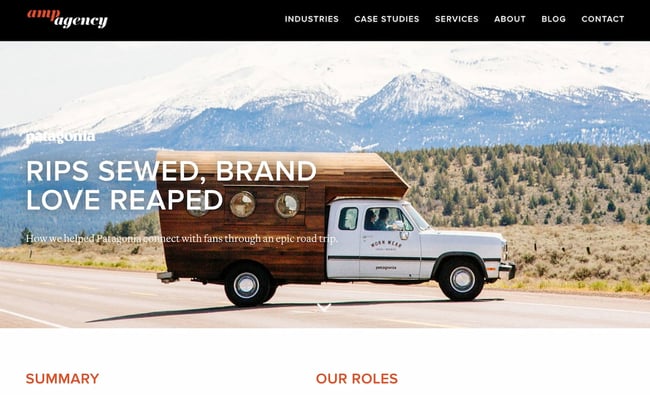
Amp Agency’s Patagonia marketing strategy aimed to appeal to a new audience through guerrilla marketing efforts and a coast-to-coast road trip. Their case study page effectively conveys a voyager theme, complete with real photos of Patagonia customers from across the U.S., and a map of the expedition. I liked Amp Agency’s storytelling approach best. It captures viewers’ attention from start to finish simply because it’s an intriguing and unique approach to marketing.
Key Learnings from the Amp Agency Example
- Open up with a summary that communicates who your client is and why they reached out to you.
- Like in the other case study examples, you’ll want to close out with a quantitative list of your achievements.
16. “NetApp,” by Evisort

Evisort opens up its NetApp case study with an at-a-glance overview of the client. It’s imperative to always focus on the client in your case study — not on your amazing product and equally amazing team. By opening up with a snapshot of the client’s company, Evisort places the focus on the client.
This case study example checks all the boxes for a great case study that’s informative, thorough, and compelling. It includes quotes from the client and details about the challenges NetApp faced during the COVID pandemic. It closes out with a quote from the client and with a link to download the case study in PDF format, which is incredibly important if you want your case study to be accessible in a wider variety of formats.
Key Learnings from the Evisort Example
- Place the focus immediately on your client by including a snapshot of their company.
- Mention challenging eras, such as a pandemic or recession, to show how your company can help your client succeed even during difficult times.
17. “Copernicus Land Monitoring – CLC+ Core,” by Cloudflight

Including highly specialized information in your case study is an effective way to show prospects that you’re not just trying to get their business. You’re deep within their industry, too, and willing to learn everything you need to learn to create a solution that works specifically for them.
Cloudflight does a splendid job at that in its Copernicus Land Monitoring case study. While the information may be difficult to read at first glance, it will capture the interest of prospects who are in the environmental industry. It thus shows Cloudflight’s value as a partner much more effectively than a general case study would.
The page is comprehensive and ends with a compelling call-to-action — “Looking for a solution that automates, and enhances your Big Data system? Are you struggling with large datasets and accessibility? We would be happy to advise and support you!” The clean, whitespace-heavy page is an effective example of using a case study to capture future leads.
Key Learnings from the Cloudflight Case Study Example
- Don’t be afraid to get technical in your explanation of what you did for your client.
- Include a snapshot of the sales representative prospects should contact, especially if you have different sales reps for different industries, like Cloudflight does.
18. “Valvoline Increases Coupon Send Rate by 76% with Textel’s MMS Picture Texting,” by Textel

If you’re targeting large enterprises with a long purchasing cycle, you’ll want to include a wealth of information in an easily transferable format. That’s what Textel does here in its PDF case study for Valvoline. It greets the user with an eye-catching headline that shows the value of using Textel. Valvoline saw a significant return on investment from using the platform.
Another smart decision in this case study is highlighting the client’s quote by putting it in green font and doing the same thing for the client’s results because it helps the reader quickly connect the two pieces of information. If you’re in a hurry, you can also take a look at the “At a Glance” column to get the key facts of the case study, starting with information about Valvoline.
Key Learnings from the Textel Case Study Example
- Include your client’s ROI right in the title of the case study.
- Add an “At a Glance” column to your case study PDF to make it easy to get insights without needing to read all the text.
19. “Hunt Club and Happeo — a tech-enabled love story,” by Happeo
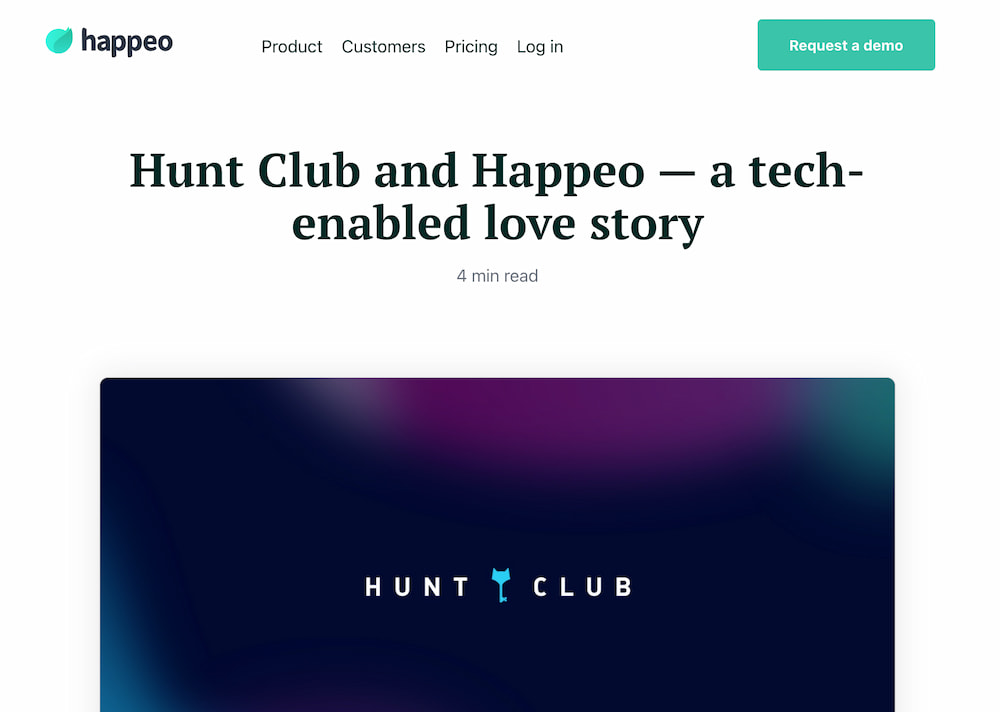
In this blog-post-like case study, Happeo opens with a quote from the client, then dives into a compelling heading: “Technology at the forefront of Hunt Club’s strategy.” Say you’re investigating Happeo as a solution and consider your firm to be technology-driven. This approach would spark your curiosity about why the client chose to work with Happeo. It also effectively communicates the software’s value proposition without sounding like it’s coming from an in-house marketing team.
Every paragraph is a quote written from the customer’s perspective. Later down the page, the case study also dives into “the features that changed the game for Hunt Club,” giving Happeo a chance to highlight some of the platform’s most salient features.
Key Learnings from the Happeo Case Study Example
- Consider writing the entirety of the case study from the perspective of the customer.
- Include a list of the features that convinced your client to go with you.
20. “Red Sox Season Campaign,” by CTP Boston
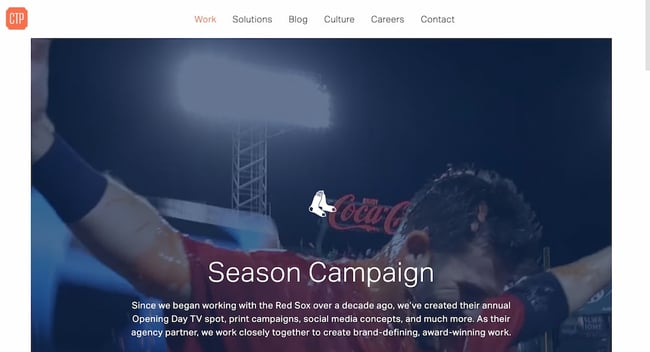
What’s great about CTP’s case study page for their Red Sox Season Campaign is their combination of video, images, and text. A video automatically begins playing when you visit the page, and as you scroll, you’ll see more embedded videos of Red Sox players, a compilation of print ads, and social media images you can click to enlarge.
At the bottom, it says “Find out how we can do something similar for your brand.” The page is clean, cohesive, and aesthetically pleasing. It invites viewers to appreciate the well-roundedness of CTP’s campaign for Boston’s beloved baseball team.
Key Learnings from the CTP Case Study Example
- Include a video in the heading of the case study.
- Close with a call-to-action that makes leads want to turn into prospects.
21. “Acoustic,” by Genuine
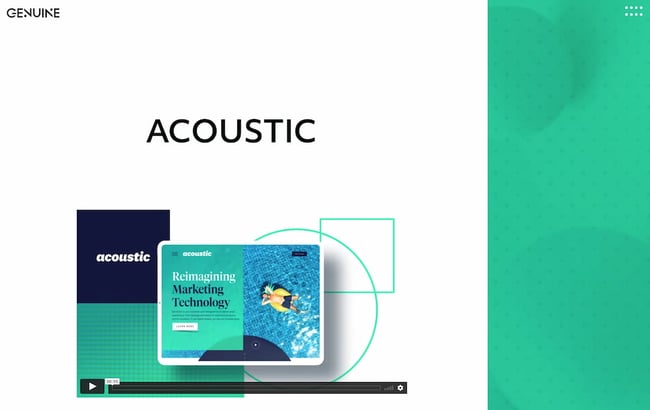
Sometimes, simple is key. Genuine’s case study for Acoustic is straightforward and minimal, with just a few short paragraphs, including “Reimagining the B2B website experience,” “Speaking to marketers 1:1,” and “Inventing Together.” After the core of the case study, we then see a quote from Acoustic’s CMO and the results Genuine achieved for the company.
The simplicity of the page allows the reader to focus on both the visual aspects and the copy. The page displays Genuine’s brand personality while offering the viewer all the necessary information they need.
Key Learnings from the CTP Case Study Example
- You don’t need to write a lot to create a great case study. Keep it simple.
- Always include quantifiable data to illustrate the results you achieved for your client.
22. “Using Apptio Targetprocess Automated Rules in Wargaming,” by Apptio
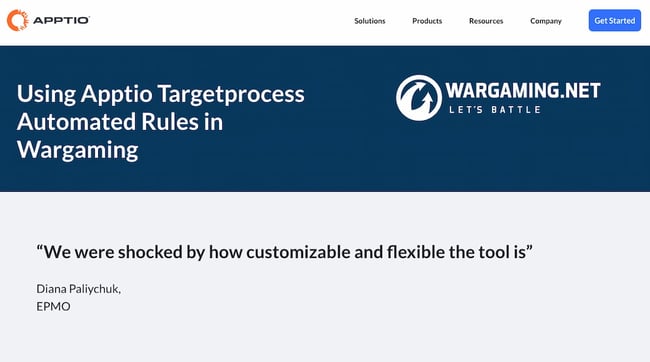
Apptio’s case study for Wargaming summarizes three key pieces of information right at the beginning: The goals, the obstacles, and the results.
Readers then have the opportunity to continue reading — or they can walk away right then with the information they need. This case study also excels in keeping the human interest factor by formatting the information like an interview.
The piece is well-organized and uses compelling headers to keep the reader engaged. Despite its length, Apptio’s case study is appealing enough to keep the viewer’s attention. Every Apptio case study ends with a “recommendation for other companies” section, where the client can give advice for other companies that are looking for a similar solution but aren’t sure how to get started.
Key Learnings from the Apptio Case Study Example
- Put your client in an advisory role by giving them the opportunity to give recommendations to other companies that are reading the case study.
- Include the takeaways from the case study right at the beginning so prospects quickly get what they need.
23. “Airbnb + Zendesk: building a powerful solution together,” by Zendesk

Zendesk’s Airbnb case study reads like a blog post, and focuses equally on Zendesk and Airbnb, highlighting a true partnership between the companies. To captivate readers, it begins like this: “Halfway around the globe is a place to stay with your name on it. At least for a weekend.”
The piece focuses on telling a good story and provides photographs of beautiful Airbnb locations. In a case study meant to highlight Zendesk’s helpfulness, nothing could be more authentic than their decision to focus on Airbnb’s service in such great detail.
Key Learnings from the Zendesk Case Study Example
- Include images of your client’s offerings — not necessarily of the service or product you provided. Notice how Zendesk doesn’t include screenshots of its product.
- Include a call-to-action right at the beginning of the case study. Zendesk gives you two options: to find a solution or start a trial.
24. “Biobot Customer Success Story: Rollins College, Winter Park, Florida,” by Biobot
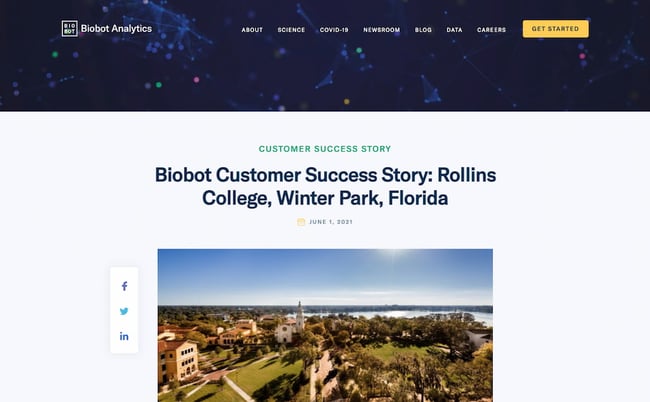
Like some of the other top examples in this list, Biobot opens its case study with a quote from its client, which captures the value proposition of working with Biobot. It mentions the COVID pandemic and goes into detail about the challenges the client faced during this time.
This case study is structured more like a news article than a traditional case study. This format can work in more formal industries where decision-makers need to see in-depth information about the case. Be sure to test different methods and measure engagement.
Key Learnings from the Biobot Case Study Example
- Mention environmental, public health, or economic emergencies and how you helped your client get past such difficult times.
- Feel free to write the case study like a normal blog post, but be sure to test different methods to find the one that best works for you.
25. “Discovering Cost Savings With Efficient Decision Making,” by Gartner

You don’t always need a ton of text or a video to convey your message — sometimes, you just need a few paragraphs and bullet points. Gartner does a fantastic job of quickly providing the fundamental statistics a potential customer would need to know, without boggling down their readers with dense paragraphs. The case study closes with a shaded box that summarizes the impact that Gartner had on its client. It includes a quote and a call-to-action to “Learn More.”
Key Learnings from the Gartner Case Study Example
- Feel free to keep the case study short.
- Include a call-to-action at the bottom that takes the reader to a page that most relates to them.
26. “Bringing an Operator to the Game,” by Redapt

This case study example by Redapt is another great demonstration of the power of summarizing your case study’s takeaways right at the start of the study. Redapt includes three easy-to-scan columns: “The problem,” “the solution,” and “the outcome.” But its most notable feature is a section titled “Moment of clarity,” which shows why this particular project was difficult or challenging.
The section is shaded in green, making it impossible to miss. Redapt does the same thing for each case study. In the same way, you should highlight the “turning point” for both you and your client when you were working toward a solution.
Key Learnings from the Redapt Case Study Example
- Highlight the turning point for both you and your client during the solution-seeking process.
- Use the same structure (including the same headings) for your case studies to make them easy to scan and read.
27. “Virtual Call Center Sees 300% Boost In Contact Rate,” by Convoso
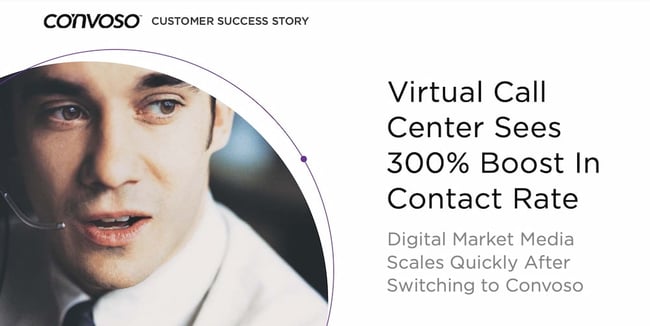
Convoso’s PDF case study for Digital Market Media immediately mentions the results that the client achieved and takes advantage of white space. On the second page, the case study presents more influential results. It’s colorful and engaging and closes with a spread that prompts readers to request a demo.
Key Learnings from the Convoso Case Study Example
- List the results of your work right at the beginning of the case study.
- Use color to differentiate your case study from others. Convoso’s example is one of the most colorful ones on this list.
28. “Ensuring quality of service during a pandemic,” by Ericsson

Ericsson’s case study page for Orange Spain is an excellent example of using diverse written and visual media — such as videos, graphs, and quotes — to showcase the success a client experienced. Throughout the case study, Ericsson provides links to product and service pages users might find relevant as they’re reading the study.
For instance, under the heading “Preloaded with the power of automation,” Ericsson mentions its Ericsson Operations Engine product, then links to that product page. It closes the case study with a link to another product page.
Key Learnings from the Ericsson Case Study Example
- Link to product pages throughout the case study so that readers can learn more about the solution you offer.
- Use multimedia to engage users as they read the case study.
Start creating your case study.
Now that you’ve got a great list of examples of case studies, think about a topic you’d like to write about that highlights your company or work you did with a customer.
A customer’s success story is the most persuasive marketing material you could ever create. With a strong portfolio of case studies, you can ensure prospects know why they should give you their business.
Editor’s note: This post was originally published in August 2018 and has been updated for comprehensiveness.
MARKETING
Should Your Brand Shout Its AI and Marketing Plan to the World?

To use AI or not to use AI, that is the question.
Let’s hope things work out better for you than they did for Shakespeare’s mad Danish prince with daddy issues.
But let’s add a twist to that existential question.
CMI’s chief strategy officer, Robert Rose, shares what marketers should really contemplate. Watch the video or read on to discover what he says:
Should you not use AI and be proud of not using it? Dove Beauty did that last week.
Should you use it but keep it a secret? Sports Illustrated did that last year.
Should you use AI and be vocal about using it? Agency giant Brandtech Group picked up the all-in vibe.
Should you not use it but tell everybody you are? The new term “AI washing” is hitting everywhere.
What’s the best option? Let’s explore.
Dove tells all it won’t use AI
Last week, Dove, the beauty brand celebrating 20 years of its Campaign for Real Beauty, pledged it would NEVER use AI in visual communication to portray real people.
In the announcement, they said they will create “Real Beauty Prompt Guidelines” that people can use to create images representing all types of physical beauty through popular generative AI programs. The prompt they picked for the launch video? “The most beautiful woman in the world, according to Dove.”
I applaud them for the powerful ad. But I’m perplexed by Dove issuing a statement saying it won’t use AI for images of real beauty and then sharing a branded prompt for doing exactly that. Isn’t it like me saying, “Don’t think of a parrot eating pizza. Don’t think about a parrot eating pizza,” and you can’t help but think about a parrot eating pizza right now?
Brandtech Group says it’s all in on AI
Now, Brandtech Group, a conglomerate ad agency, is going the other way. It’s going all-in on AI and telling everybody.
This week, Ad Age featured a press release — oops, I mean an article (subscription required) — with the details of how Brandtech is leaning into the takeaway from OpenAI’s Sam Altman, who says 95% of marketing work today can be done by AI.
A Brandtech representative talked about how they pitch big brands with two people instead of 20. They boast about how proud they are that its lean 7,000 staffers compete with 100,000-person teams. (To be clear, showing up to a pitch with 20 people has never been a good thing, but I digress.)
OK, that’s a differentiated approach. They’re all in. Ad Age certainly seemed to like it enough to promote it. Oops, I mean report about it.
False claims of using AI and not using AI
Offshoots of the all-in and never-will approaches also exist.
The term “AI washing” is de rigueur to describe companies claiming to use AI for something that really isn’t AI. The US Securities and Exchange Commission just fined two companies for using misleading statements about their use of AI in their business model. I know one startup technology organization faced so much pressure from their board and investors to “do something with AI” that they put a simple chatbot on their website — a glorified search engine — while they figured out what they wanted to do.
Lastly and perhaps most interestingly, companies have and will use AI for much of what they create but remain quiet about it or desire to keep it a secret. A recent notable example is the deepfake ad of a woman in a car professing the need for people to use a particular body wipe to get rid of body odor. It was purported to be real, but sharp-eyed viewers suspected the fake and called out the company, which then admitted it. Or was that the brand’s intent all along — the AI-use outrage would bring more attention?
This is an AI generated influencer video.
Looks 100% real. Even the interior car detailing.
UGC content for your brand is about to get really cheap. ☠️ pic.twitter.com/2m10RqoOW3
— Jon Elder | Amazon Growth | Private Label (@BlackLabelAdvsr) March 26, 2024
To yell or not to yell about your brand’s AI decision
Should a brand yell from a mountaintop that they use AI to differentiate themselves a la Brandtech? Or should a brand yell they’re never going to use AI to differentiate themselves a la Dove? Or should a brand use it and not yell anything? (I think it’s clear that a brand should not use AI and lie and say it is. That’s the worst of all choices.)
I lean far into not-yelling-from-mountaintop camp.
When I see a CEO proudly exclaim that they laid off 90% of their support workforce because of AI, I’m not surprised a little later when the value of their service is reduced, and the business is failing.
I’m not surprised when I hear “AI made us do it” to rationalize the latest big tech company latest rounds of layoffs. Or when a big consulting firm announces it’s going all-in on using AI to replace its creative and strategic resources.
I see all those things as desperate attempts for short-term attention or a distraction from the real challenge. They may get responses like, “Of course, you had to lay all those people off; AI is so disruptive,” or “Amazing. You’re so out in front of the rest of the pack by leveraging AI to create efficiency, let me cover your story.” Perhaps they get this response, “Your company deserves a bump in stock price because you’re already using this fancy new technology.”
But what happens if the AI doesn’t deliver as promoted? What happens the next time you need to lay off people? What happens the next time you need to prove your technologically forward-leaning?
Yelling out that you’re all in on a disruptive innovation, especially one the public doesn’t yet trust a lot is (at best) a business sugar high. That short-term burst of attention may or may not foul your long-term brand value.
Interestingly, the same scenarios can manifest when your brand proclaims loudly it is all out of AI, as Dove did. The sugar high may not last and now Dove has itself into a messaging box. One slip could cause distrust among its customers. And what if AI gets good at demonstrating diversity in beauty?
I tried Dove’s instructions and prompted ChatGPT for a picture of “the most beautiful woman in the world according to the Dove Real Beauty ad.”
It gave me this. Then this. And this. And finally, this.
She’s absolutely beautiful, but she doesn’t capture the many facets of diversity Dove has demonstrated in its Real Beauty campaigns. To be clear, Dove doesn’t have any control over generating the image. Maybe the prompt worked well for Dove, but it didn’t for me. Neither Dove nor you can know how the AI tool will behave.
To use AI or not to use AI?
When brands grab a microphone to answer that question, they work from an existential fear about the disruption’s meaning. They do not exhibit the confidence in their actions to deal with it.
Let’s return to Hamlet’s soliloquy:
Thus conscience doth make cowards of us all;
And thus the native hue of resolution
Is sicklied o’er with the pale cast of thought,
And enterprises of great pith and moment
With this regard their currents turn awry
And lose the name of action.
In other words, Hamlet says everybody is afraid to take real action because they fear the unknown outcome. You could act to mitigate or solve some challenges, but you don’t because you don’t trust yourself.
If I’m a brand marketer for any business (and I am), I’m going to take action on AI for my business. But until I see how I’m going to generate value with AI, I’m going to be circumspect about yelling or proselytizing how my business’ future is better.
HANDPICKED RELATED CONTENT:
Cover image by Joseph Kalinowski/Content Marketing Institute
MARKETING
How to Use AI For a More Effective Social Media Strategy, According to Ross Simmonds

Welcome to Creator Columns, where we bring expert HubSpot Creator voices to the Blogs that inspire and help you grow better.
It’s the age of AI, and our job as marketers is to keep up.
My team at Foundation Marketing recently conducted an AI Marketing study surveying hundreds of marketers, and more than 84% of all leaders, managers, SEO experts, and specialists confirmed that they used AI in the workplace.

If you can overlook the fear-inducing headlines, this technology is making social media marketers more efficient and effective than ever. Translation: AI is good news for social media marketers.
In fact, I predict that the marketers not using AI in their workplace will be using it before the end of this year, and that number will move closer and closer to 100%.
Social media and AI are two of the most revolutionizing technologies of the last few decades. Social media has changed the way we live, and AI is changing the way we work.
So, I’m going to condense and share the data, research, tools, and strategies that the Foundation Marketing Team and I have been working on over the last year to help you better wield the collective power of AI and social media.
Let’s jump into it.
What’s the role of AI in social marketing strategy?
In a recent episode of my podcast, Create Like The Greats, we dove into some fascinating findings about the impact of AI on marketers and social media professionals. Take a listen here:
Let’s dive a bit deeper into the benefits of this technology:
Benefits of AI in Social Media Strategy
AI is to social media what a conductor is to an orchestra — it brings everything together with precision and purpose. The applications of AI in a social media strategy are vast, but the virtuosos are few who can wield its potential to its fullest.
AI to Conduct Customer Research
Imagine you’re a modern-day Indiana Jones, not dodging boulders or battling snakes, but rather navigating the vast, wild terrain of consumer preferences, trends, and feedback.
This is where AI thrives.
Using social media data, from posts on X to comments and shares, AI can take this information and turn it into insights surrounding your business and industry. Let’s say for example you’re a business that has 2,000 customer reviews on Google, Yelp, or a software review site like Capterra.
Leveraging AI you can now have all 2,000 of these customer reviews analyzed and summarized into an insightful report in a matter of minutes. You simply need to download all of them into a doc and then upload them to your favorite Generative Pre-trained Transformer (GPT) to get the insights and data you need.
But that’s not all.
You can become a Prompt Engineer and write ChatGPT asking it to help you better understand your audience. For example, if you’re trying to come up with a persona for people who enjoy marathons but also love kombucha you could write a prompt like this to ChatGPT:

The response that ChatGPT provided back is quite good:

Below this it went even deeper by including a lot of valuable customer research data:
- Demographics
- Psychographics
- Consumer behaviors
- Needs and preferences
And best of all…
It also included marketing recommendations.
The power of AI is unbelievable.
Social Media Content Using AI
AI’s helping hand can be unburdening for the creative spirit.
Instead of marketers having to come up with new copy every single month for posts, AI Social Caption generators are making it easier than ever to craft catchy status updates in the matter of seconds.
Tools like HubSpot make it as easy as clicking a button and telling the AI tool what you’re looking to create a post about:

The best part of these AI tools is that they’re not limited to one channel.
Your AI social media content assistant can help you with LinkedIn content, X content, Facebook content, and even the captions that support your post on Instagram.
It can also help you navigate hashtags:

With AI social media tools that generate content ideas or even write posts, it’s not about robots replacing humans. It’s about making sure that the human creators on your team are focused on what really matters — adding that irreplaceable human touch.
Enhanced Personalization
You know that feeling when a brand gets you, like, really gets you?
AI makes that possible through targeted content that’s tailored with a level of personalization you’d think was fortune-telling if the data didn’t paint a starker, more rational picture.
What do I mean?
Brands can engage more quickly with AI than ever before. In the early 2000s, a lot of brands spent millions of dollars to create social media listening rooms where they would hire social media managers to find and engage with any conversation happening online.
Thanks to AI, brands now have the ability to do this at scale with much fewer people all while still delivering quality engagement with the recipient.
Analytics and Insights
Tapping into AI to dissect the data gives you a CSI-like precision to figure out what works, what doesn’t, and what makes your audience tick. It’s the difference between guessing and knowing.
The best part about AI is that it can give you almost any expert at your fingertips.
If you run a report surrounding the results of your social media content strategy directly from a site like LinkedIn, AI can review the top posts you’ve shared and give you clear feedback on what type of content is performing, why you should create more of it, and what days of the week your content is performing best.
This type of insight that would typically take hours to understand.
Now …
Thanks to the power of AI you can upload a spreadsheet filled with rows and columns of data just to be met with a handful of valuable insights a few minutes later.
Improved Customer Service
Want 24/7 support for your customers?
It’s now possible without human touch.
Chatbots powered by AI are taking the lead on direct messaging experiences for brands on Facebook and other Meta properties to offer round-the-clock assistance.
The fact that AI can be trained on past customer queries and data to inform future queries and problems is a powerful development for social media managers.
Advertising on Social Media with AI
The majority of ad networks have used some variation of AI to manage their bidding system for years. Now, thanks to AI and its ability to be incorporated in more tools, brands are now able to use AI to create better and more interesting ad campaigns than ever before.
Brands can use AI to create images using tools like Midjourney and DALL-E in seconds.
Brands can use AI to create better copy for their social media ads.
Brands can use AI tools to support their bidding strategies.
The power of AI and social media is continuing to evolve daily and it’s not exclusively found in the organic side of the coin. Paid media on social media is being shaken up due to AI just the same.
How to Implement AI into Your Social Media Strategy
Ready to hit “Go” on your AI-powered social media revolution?
Don’t just start the engine and hope for the best. Remember the importance of building a strategy first. In this video, you can learn some of the most important factors ranging from (but not limited to) SMART goals and leveraging influencers in your day-to-day work:
The following seven steps are crucial to building a social media strategy:
- Identify Your AI and Social Media Goals
- Validate Your AI-Related Assumptions
- Conduct Persona and Audience Research
- Select the Right Social Channels
- Identify Key Metrics and KPIs
- Choose the Right AI Tools
- Evaluate and Refine Your Social Media and AI Strategy
Keep reading, roll up your sleeves, and follow this roadmap:
1. Identify Your AI and Social Media Goals
If you’re just dipping your toes into the AI sea, start by defining clear objectives.
Is it to boost engagement? Streamline your content creation? Or simply understand your audience better? It’s important that you spend time understanding what you want to achieve.
For example, say you’re a content marketing agency like Foundation and you’re trying to increase your presence on LinkedIn. The specificity of this goal will help you understand the initiatives you want to achieve and determine which AI tools could help you make that happen.
Are there AI tools that will help you create content more efficiently? Are there AI tools that will help you optimize LinkedIn Ads? Are there AI tools that can help with content repurposing? All of these things are possible and having a goal clearly identified will help maximize the impact. Learn more in this Foundation Marketing piece on incorporating AI into your content workflow.
Once you have identified your goals, it’s time to get your team on board and assess what tools are available in the market.
Recommended Resources:
2. Validate Your AI-Related Assumptions
Assumptions are dangerous — especially when it comes to implementing new tech.
Don’t assume AI is going to fix all your problems.
Instead, start with small experiments and track their progress carefully.
3. Conduct Persona and Audience Research
Social media isn’t something that you can just jump into.
You need to understand your audience and ideal customers. AI can help with this, but you’ll need to be familiar with best practices. If you need a primer, this will help:
Once you understand the basics, consider ways in which AI can augment your approach.
4. Select the Right Social Channels
Not every social media channel is the same.
It’s important that you understand what channel is right for you and embrace it.
The way you use AI for X is going to be different from the way you use AI for LinkedIn. On X, you might use AI to help you develop a long-form thread that is filled with facts and figures. On LinkedIn however, you might use AI to repurpose a blog post and turn it into a carousel PDF. The content that works on X and that AI can facilitate creating is different from the content that you can create and use on LinkedIn.
The audiences are different.
The content formats are different.
So operate and create a plan accordingly.
Recommended Tools and Resources:
5. Identify Key Metrics and KPIs
What metrics are you trying to influence the most?
Spend time understanding the social media metrics that matter to your business and make sure that they’re prioritized as you think about the ways in which you use AI.
These are a few that matter most:
- Reach: Post reach signifies the count of unique users who viewed your post. How much of your content truly makes its way to users’ feeds?
- Clicks: This refers to the number of clicks on your content or account. Monitoring clicks per campaign is crucial for grasping what sparks curiosity or motivates people to make a purchase.
- Engagement: The total social interactions divided by the number of impressions. This metric reveals how effectively your audience perceives you and their readiness to engage.
Of course, it’s going to depend greatly on your business.
But with this information, you can ensure that your AI social media strategy is rooted in goals.
6. Choose the Right AI Tools
The AI landscape is filled with trash and treasure.
Pick AI tools that are most likely to align with your needs and your level of tech-savviness.
For example, if you’re a blogger creating content about pizza recipes, you can use HubSpot’s AI social caption generator to write the message on your behalf:

The benefit of an AI tool like HubSpot and the caption generator is that what at one point took 30-40 minutes to come up with — you can now have it at your fingertips in seconds. The HubSpot AI caption generator is trained on tons of data around social media content and makes it easy for you to get inspiration or final drafts on what can be used to create great content.
Consider your budget, the learning curve, and what kind of support the tool offers.
7. Evaluate and Refine Your Social Media and AI Strategy
AI isn’t a magic wand; it’s a set of complex tools and technology.
You need to be willing to pivot as things come to fruition.
If you notice that a certain activity is falling flat, consider how AI can support that process.
Did you notice that your engagement isn’t where you want it to be? Consider using an AI tool to assist with crafting more engaging social media posts.
Make AI Work for You — Now and in the Future
AI has the power to revolutionize your social media strategy in ways you may have never thought possible. With its ability to conduct customer research, create personalized content, and so much more, thinking about the future of social media is fascinating.
We’re going through one of the most interesting times in history.
Stay equipped to ride the way of AI and ensure that you’re embracing the best practices outlined in this piece to get the most out of the technology.
MARKETING
Advertising in local markets: A playbook for success

Many brands, such as those in the home services industry or a local grocery chain, market to specific locations, cities or regions. There are also national brands that want to expand in specific local markets.
Regardless of the company or purpose, advertising on a local scale has different tactics than on a national scale. Brands need to connect their messaging directly with the specific communities they serve and media to their target demo. Here’s a playbook to help your company succeed when marketing on a local scale.
1. Understand local vs. national campaigns
Local advertising differs from national campaigns in several ways:
- Audience specificity: By zooming in on precise geographic areas, brands can tailor messaging to align with local communities’ customs, preferences and nuances. This precision targeting ensures that your message resonates with the right target audience.
- Budget friendliness: Local advertising is often more accessible for small businesses. Local campaign costs are lower, enabling brands to invest strategically within targeted locales. This budget-friendly nature does not diminish the need for strategic planning; instead, it emphasizes allocating resources wisely to maximize returns. As a result, testing budgets can be allocated across multiple markets to maximize learnings for further market expansion.
- Channel selection: Selecting the correct channels is vital for effective local advertising. Local newspapers, radio stations, digital platforms and community events each offer advantages. The key lies in understanding where your target audience spends time and focusing efforts to ensure optimal engagement.
- Flexibility and agility: Local campaigns can be adjusted more swiftly in response to market feedback or changes, allowing brands to stay relevant and responsive.
Maintaining brand consistency across local touchpoints reinforces brand identity and builds a strong, recognizable brand across markets.
2. Leverage customized audience segmentation
Customized audience segmentation is the process of dividing a market into distinct groups based on specific demographic criteria. This marketing segmentation supports the development of targeted messaging and media plans for local markets.
For example, a coffee chain might cater to two distinct segments: young professionals and retirees. After identifying these segments, the chain can craft messages, offers and media strategies relating to each group’s preferences and lifestyle.
To reach young professionals in downtown areas, the chain might focus on convenience, quality coffee and a vibrant atmosphere that is conducive to work and socializing. Targeted advertising on Facebook, Instagram or Connected TV, along with digital signage near office complexes, could capture the attention of this demographic, emphasizing quick service and premium blends.
Conversely, for retirees in residential areas, the chain could highlight a cozy ambiance, friendly service and promotions such as senior discounts. Advertisements in local print publications, community newsletters, radio stations and events like senior coffee mornings would foster a sense of community and belonging.
Dig deeper: Niche advertising: 7 actionable tactics for targeted marketing
3. Adapt to local market dynamics
Various factors influence local market dynamics. Brands that navigate changes effectively maintain a strong audience connection and stay ahead in the market. Here’s how consumer sentiment and behavior may evolve within a local market and the corresponding adjustments brands can make.
- Cultural shifts, such as changes in demographics or societal norms, can alter consumer preferences within a local community. For example, a neighborhood experiencing gentrification may see demand rise for specific products or services.
- Respond by updating your messaging to reflect the evolving cultural landscape, ensuring it resonates with the new demographic profile.
- Economic conditions are crucial. For example, during downturns, consumers often prioritize value and practicality.
- Highlight affordable options or emphasize the practical benefits of your offerings to ensure messaging aligns with consumers’ financial priorities. The impact is unique to each market and the marketing message must also be dynamic.
- Seasonal trends impact consumer behavior.
- Align your promotions and creative content with changing seasons or local events to make your offerings timely and relevant.
- New competitors. The competitive landscape demands vigilance because new entrants or innovative competitor campaigns can shift consumer preferences.
- Differentiate by focusing on your unique selling propositions, such as quality, customer service or community involvement, to retain consumer interest and loyalty.
4. Apply data and predictive analytics
Data and predictive analytics are indispensable tools for successfully reaching local target markets. These technologies provide consumer behavior insights, enabling you to anticipate market trends and adjust strategies proactively.
- Price optimization: By analyzing consumer demand, competitor pricing and market conditions, data analytics enables you to set prices that attract customers while ensuring profitability.
- Competitor analysis: Through analysis, brands can understand their positioning within the local market landscape and identify opportunities and threats. Predictive analytics offer foresight into competitors’ potential moves, allowing you to strategize effectively to maintain a competitive edge.
- Consumer behavior: Forecasting consumer behavior allows your brand to tailor offerings and marketing messages to meet evolving consumer needs and enhance engagement.
- Marketing effectiveness: Analytics track the success of advertising campaigns, providing insights into which strategies drive conversions and sales. This feedback loop enables continuous optimization of marketing efforts for maximum impact.
- Inventory management: In supply chain management, data analytics predict demand fluctuations, ensuring inventory levels align with market needs. This efficiency prevents stockouts or excess inventory, optimizing operational costs and meeting consumer expectations.
Dig deeper: Why you should add predictive modeling to your marketing mix
5. Counter external market influences
Consider a clothing retailer preparing for a spring collection launch. By analyzing historical weather data and using predictive analytics, the brand forecasts an unseasonably cool start to spring. Anticipating this, the retailer adjusts its campaign to highlight transitional pieces suitable for cooler weather, ensuring relevance despite an unexpected chill.
Simultaneously, predictive models signal an upcoming spike in local media advertising rates due to increased market demand. Retailers respond by reallocating a portion of advertising budgets to digital channels, which offer more flexibility and lower costs than traditional media. This shift enables brands to maintain visibility and engagement without exceeding budget, mitigating the impact of external forces on advertising.
6. Build consumer confidence with messaging
Localized messaging and tailored customer service enhance consumer confidence by demonstrating your brand’s understanding of the community. For instance, a grocery store that curates cooking classes featuring local cuisine or sponsors community events shows commitment to local culture and consumer interests.
Similarly, a bookstore highlighting local authors or topics relevant to the community resonates with local customers. Additionally, providing service that addresses local needs — such as bilingual service and local event support — reinforces the brand’s values and response to the community.
Through these localized approaches, brands can build trust and loyalty, bridging the gap between corporate presence and local relevance.
7. Dominate with local advertising
To dominate local markets, brands must:
- Harness hyper-targeted segmentation and geo-targeted advertising to reach and engage precise audiences.
- Create localized content that reflects community values, engage in community events, optimize campaigns for mobile and track results.
- Fine-tune strategies, outperform competitors and foster lasting relationships with customers.
These strategies will enable your message to resonate with local consumers, differentiate you in competitive markets and ensure you become a major player in your specific area.
Dig deeper: The 5 critical elements for local marketing success
Opinions expressed in this article are those of the guest author and not necessarily MarTech. Staff authors are listed here.
-

 PPC5 days ago
PPC5 days ago19 Best SEO Tools in 2024 (For Every Use Case)
-
SEARCHENGINES7 days ago
Daily Search Forum Recap: April 17, 2024
-
SEARCHENGINES6 days ago
Daily Search Forum Recap: April 18, 2024
-
SEARCHENGINES5 days ago
Daily Search Forum Recap: April 19, 2024
-

 MARKETING6 days ago
MARKETING6 days agoEcommerce evolution: Blurring the lines between B2B and B2C
-

 SEO6 days ago
SEO6 days ago2024 WordPress Vulnerability Report Shows Errors Sites Keep Making
-

 WORDPRESS5 days ago
WORDPRESS5 days agoHow to Make $5000 of Passive Income Every Month in WordPress
-

 WORDPRESS6 days ago
WORDPRESS6 days ago10 Amazing WordPress Design Resouces – WordPress.com News
















![How to Use AI For a More Effective Social Media Strategy, According to Ross Simmonds Download Now: The 2024 State of Social Media Trends [Free Report]](https://articles.entireweb.com/wp-content/uploads/2024/04/How-to-Use-AI-For-a-More-Effective-Social-Media.png)

